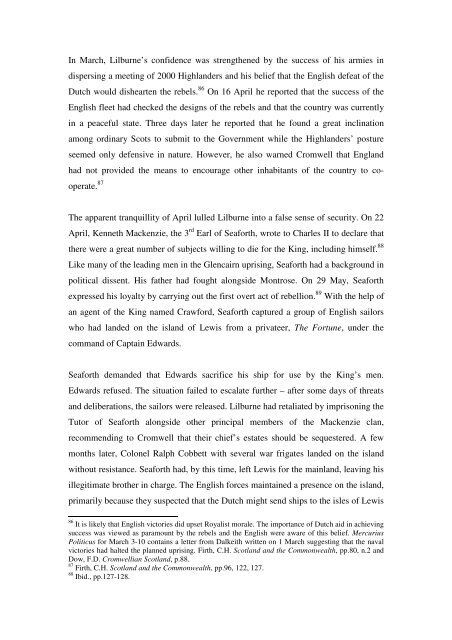The Glencairn Uprising, 1653-54 Helen Baker Department of ...
The Glencairn Uprising, 1653-54 Helen Baker Department of ...
The Glencairn Uprising, 1653-54 Helen Baker Department of ...
You also want an ePaper? Increase the reach of your titles
YUMPU automatically turns print PDFs into web optimized ePapers that Google loves.
In March, Lilburne’s confidence was strengthened by the success <strong>of</strong> his armies in<br />
dispersing a meeting <strong>of</strong> 2000 Highlanders and his belief that the English defeat <strong>of</strong> the<br />
Dutch would dishearten the rebels. 86 On 16 April he reported that the success <strong>of</strong> the<br />
English fleet had checked the designs <strong>of</strong> the rebels and that the country was currently<br />
in a peaceful state. Three days later he reported that he found a great inclination<br />
among ordinary Scots to submit to the Government while the Highlanders’ posture<br />
seemed only defensive in nature. However, he also warned Cromwell that England<br />
had not provided the means to encourage other inhabitants <strong>of</strong> the country to cooperate.<br />
87<br />
<strong>The</strong> apparent tranquillity <strong>of</strong> April lulled Lilburne into a false sense <strong>of</strong> security. On 22<br />
April, Kenneth Mackenzie, the 3 rd Earl <strong>of</strong> Seaforth, wrote to Charles II to declare that<br />
there were a great number <strong>of</strong> subjects willing to die for the King, including himself. 88<br />
Like many <strong>of</strong> the leading men in the <strong>Glencairn</strong> uprising, Seaforth had a background in<br />
political dissent. His father had fought alongside Montrose. On 29 May, Seaforth<br />
expressed his loyalty by carrying out the first overt act <strong>of</strong> rebellion. 89 With the help <strong>of</strong><br />
an agent <strong>of</strong> the King named Crawford, Seaforth captured a group <strong>of</strong> English sailors<br />
who had landed on the island <strong>of</strong> Lewis from a privateer, <strong>The</strong> Fortune, under the<br />
command <strong>of</strong> Captain Edwards.<br />
Seaforth demanded that Edwards sacrifice his ship for use by the King’s men.<br />
Edwards refused. <strong>The</strong> situation failed to escalate further – after some days <strong>of</strong> threats<br />
and deliberations, the sailors were released. Lilburne had retaliated by imprisoning the<br />
Tutor <strong>of</strong> Seaforth alongside other principal members <strong>of</strong> the Mackenzie clan,<br />
recommending to Cromwell that their chief’s estates should be sequestered. A few<br />
months later, Colonel Ralph Cobbett with several war frigates landed on the island<br />
without resistance. Seaforth had, by this time, left Lewis for the mainland, leaving his<br />
illegitimate brother in charge. <strong>The</strong> English forces maintained a presence on the island,<br />
primarily because they suspected that the Dutch might send ships to the isles <strong>of</strong> Lewis<br />
86 It is likely that English victories did upset Royalist morale. <strong>The</strong> importance <strong>of</strong> Dutch aid in achieving<br />
success was viewed as paramount by the rebels and the English were aware <strong>of</strong> this belief. Mercurius<br />
Politicus for March 3-10 contains a letter from Dalkeith written on 1 March suggesting that the naval<br />
victories had halted the planned uprising. Firth, C.H. Scotland and the Commonwealth, pp.80, n.2 and<br />
Dow, F.D. Cromwellian Scotland, p.88.<br />
87 Firth, C.H. Scotland and the Commonwealth, pp.96, 122, 127.<br />
88 Ibid., pp.127-128.
















